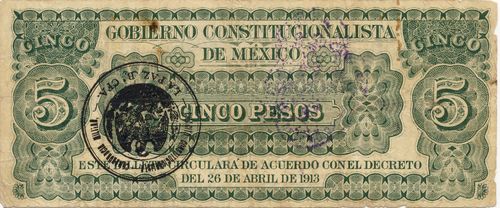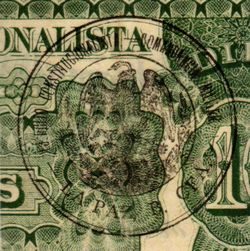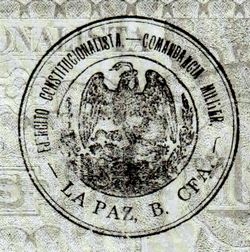The Junta Neutral and Carrancistas
The Junta Neutral
The Junta Neutral was composed of Luis Pozo, Eduardo S. Carrillo, Felipe R. Cota and Alejandro E. Allison. Once in power, the first problem it faced was the circulation of paper money because much of it was issued in the states of Chihuahua and Sonora, which prevented commercial transactions with the regions under the control of the Carrancistas. Therefore, on the same day, 29 May 1915, a meeting of the general public, including most of the businesses in the capital, having agreed that the occupation of Baja California by any faction had no strategic purpose; that no advantage had been derived from accepting the Convention government; that the territory was reliant on its own resources , which would soon run out; that businesses needed to be free to trade; and that the opening of the ports on the West Coast, now held by the Carrancistas, would effect the provision of notes (El Pueblo va que con la apertura de los puertos de la costa occidental de la República, de donde se ha abastecido este Distrito y que ahora están cerrados al tráfico, debido a que se hayan ocupados por los Carrancistas, tendrá provisiones suficientes sobre los billetes de otros valores) accepted a proposal by Eduardo S. Carrillo that:
1. The currency for commercial transactions should be gold, silver, banknotes and other provisional notes that were in general circulation in the country;
2. Notes that had been restamped by the Jefatura Política should be of forced circulation;
3. The period for revalidation should be extended by ten days in the city and fifteen outside, with the revalidation and accepting unrevalidated notes both being optional;
4. The premium for preferred notes over the others could not be greater than 10%.
Otto Graff, manager of the local branch of the Banco de Sonora, offered to help with any exchange.
Once Carrillo’s proposal had been accepted, it was agreed that any criminal sanction for enforcement should be left to the Jefatura de Armas as the Junta Neutral was only a consultative bodyABCS, Gobernación, vol. 648, exp. 106.
Despite the fact that it was permissible to depreciate the currency that was not considered legal tender, the merchants refused to accept it on the grounds that their suppliers demanded Carrancista currency; The same position was taken by producers, on the grounds that they could only buy their main goods with Sinaloa currency. The Junta Neutral accepted this, with the warning that this did not mean they preferred one faction over the other. However, their actions reflected the opposite. For example, at a meeting with businessmen on 8 June they reconfirmed the agreement made on 29 May regarding legal tender in the district, but completely ignored the Villista notes that could previously circulate at a discount on their face valueABCS, Gobernación, vol. 648, exp. 106.
The priority for the new authorities, as an integral part of the group of merchants and businessmen, was to resolve this matter of the legal currency. After favouring the Carrancista currency, the Junta Gubernativa took care to justify its political position in letters to José María Maytorena, the governor of Sonora; Ramón F. Iturbe, the head of the Carrancista forces in Sinaloa; Félix Ortega, the deposed jefe político; and Félix Justino Ortega, who was in arms against the government at the southern end of the district. It argued that the coup d'état was a consequence, among other reasons, of the economic circumstancesABCS, Guerra, vol. 636bis, exp. 74, doc. 235, letters of 31 May and 5 June 1915.
On 15 June 1915 the Presidente Municipal of San José del Cabo, Jesús C. Ojeda, reported that several businesses and individuals had asked if, because of the difficulties in receiving restamped notes, they themselves could restamp them (after a meticulous examination)ABCS, Gobernación, vol. 642, exp. 150. The Junta Gubernativa Neutral seems to have initially agreed, for a ten day period,ibid. but on 18 June said that it could not delegate this power, so it was more prudent to send note to La Paz for revalidationABCS, Gobernación, vol. 642, exp. 150. Should we expect any San José del Cabo revalidation?
In an obvious attempt to withdraw certain issues on 24 June the Presidente Municipal of La Paz told his council, in the payment of taxes, to accept 50% in Gobierno Provisional de México and Brigada de Sinaloa and the other half in notes in general circulation (los de circulación de esta plaza)ABCS, Gobernación, vol. 648 bis 4/4, D/S oficio núm. 46, 24 June 1915. Then on 1 July the Jefe Político, in circular núm. 4, ordered that 50% should be paid in Ejército Constitucionalista notes{{/footnote] ABCS, Gobernación, vol. 642, exp. 150.
On 29 June 1915 Capitán 2º B. Manríquez, in El Triunfo, reported to the Jefe de Armas that storekeepers did not want to sell for Chihuahua notes, even though he was being paid with this type of currency. The Jefe de Armas ordered the Presidente Municipal to impose fines on those who refused{/footnote]ibid..
The Carrancistas
When the Carrancista Urbano Angulo took over as jefe politíco on 7 July 1915, he ordered that the paper currency used in the district should be the Carrancista Ejército Constitucionalista de México issue. However, this caused difficulties as businesses and individuals mostly held other issues such as the Monclova, dos caritas, Brigada de Sinaloa, Estado de Sonora and Cornejo, so he decided to allow those that had been validated with the resello of the Jefatura Política or Presidente Municipal, with the exception of the Villista issues (i.e. the Estado de Sonora and the dos caritas).
A resello known, so far, just on Monclova notes (and so probably a Carrancista revalidation) was "EJERCITO CONSTITUCIONALISTA, - COMANDANCIA MILITAR, - LA PAZ., B. CFA. - ".

 |
 |
On 8 July Angulo informed the public that Gobierno Provisional de México and Brigada de Sinaloa were of forced circulationABCS, Gobernación, vol. 642, exp. 150. Then, two days later, he announced that notes revalidated by his Comandancia Militar were of obligatory acceptance in local transactions, but he was already taking steps to arrange their exchangeABCS, Gobernación, vol. 640bis, exp. 63. On 10 July Angulo told the Presidente Municipal of El Triunfo that the paper money of forced circulation comprised the Ejército Constitucionalista, the Gobierno Provisional, the Brigada de Sinaloa, Estado de Sinaloa and those of the Ejército del Noroeste Sinaloa, with the warning that whoever contravened this measure would be liable to a fine of $500. or sixty days arrestABCS, Gobernación, vol. 642, exp. 150, telegram Angulo to Presidente Municipal, El Triunfo, 10 July 1915.
On 2 August a further decree, num. 2, suspended the circulation of the revalidated local issues, leaving the Ejército Constitucionalista de México notes in circulation.
So we might expect a selection of validations but in fact these are rare, with the legend “REPUBLICA MEXICANA, LA PAZ, B. C.” known on the Ejército Constitucionalista issue (which was probably applied during Ortega's regime).
On 11 July Capitán 1º Ed Burns reported that the next day he was going to revalidate notes with the seal of the local town council. He was told that he could revalidate the notes from 1913 and 1914, but the ones issued in 1915 were completely worthlessABCS, Gobernación, vol. 642, exp. 150. What was the result of this decision?
On 20 July Angulo, in his circular núm. 3, had to remind businesses to accept revalidated notes, with the threat of a $500 fine or sixty days imprisonmentibid.. Four days later, Todos Santos reported that most of the money there lacked the resello, and asked whether the Presidencia Municipal or Tesorería could revalidate notes and was told it could revalidate Cornejo notes, sábanas and Monclova as long as they were not counterfeit. The Brigada de Sinaloa, Ejército Constitucionalista and Gobierno Provisional de México notes were of forced circulation, without the need for a reselloibid..
On 5 October 1915 the Comandante Militar, J. L. Yagomín, published a notice in response to repeated rumours that the Mexico Gobierno Provisional notes had been withdrawn. He has asked the Cuartel General of the 3a. División del Noroeste, about the validity of certain issues, which were presumably in circulation in the district, namely the Estado de Sinaloa, Durango and Ejército del Noroeste, and was told that the issues in forced circulation were the Veracruz Gobierno Provisional, the 31 December issue from Durango, and all the notes of the Ejército del Noroeste, Brigada de Sinaloa and Estado de Sinaloa. He repeated Carranza’s decree on the withdrawal of Mexico Gobierno Provisional notesABCS, Gobernación, vol. 640bis, exp. 63.
The same day he added a notice that the Ejercito Constitucionalista notes continued to be of forced circulation and punished payment in banknotes.
On 3 January 1916 the Jefe de Hacienda, A. Duhagon, said that Durango and Sinaloa notes should be deposited in the Jefatura or the Administraciones del Timbre during the first half of the month, with a view to a later exchangeABCS, Hacienda, vol. 658 1/2, exp. 50.
On 15 January 1916 Angulo wrote to the Administrador de la Aduana in La Paz telling him that as the Ejército Constitucionalista and Brigada de Sinaloa notes were being withdrawn he should collect any such notes that arriving passengers brought in to the state, giving a receipt. People in transit would have their notes returned when they embarked. He had already ordered that existing stocks should be restamped within the next five daysibid., though it is unsure to what end, since they were being withdrawn from circulation.
Baja California first learnt unofficially of Carranza’s circular núm. 48 for handing in Chihuahua notes after the end of the year so on 21 January 1916 Angulo asked for an extensionibid. and the period was extended until February 1916.
On 12 April 1916 Miguel Andrade, the Oficial Mayor, published Carranza's instructions for dealing with establishments that closed up because of the depreciation of the currency. Two days, from Santa Rosalía, Urbano had a printed notice produced, though either intentionally or unintentionally he missed out part of the text that stated that Presidentes Municipales could sell the goods that they confiscated.
On 31 July 1916 Angulo, in the company of J. Romulo Casillas, the Visitador Permanente de la Renta del Timbre, and Arturo Valle, the Administrador of the Aduana Marítima, oversaw the incineration of $50,796.50 in notes of his rivals that had accumulated in the Comandancia Militaribid.. This probably gives a good indication of the type and number of Huertista, Villista and local notes that circulated on the peninsula. The notes incinerated were
| number | value | ||
| Chihuahua notes (probably sábanas) | |||
| 50c | 28 | $ 14.00 | |
| $5 | 335 | 1,675.00 | |
| $10 | 147 | 1,470.00 | |
| $20 | 340 | 6,800.00 | |
| $ 9,959.00 | |||
| Estado de Sonora notes | |||
| 50c | 56 | 28.00 | |
| $5 | 87 | 435.00 | |
| $10 | 107 | 1,070.00 | |
| 1,533.00 | |||
| Huertista notes (presumably La Tesorería de la Federación) | |||
| 10c | 144 | 14.40 | |
| 50c | 567 | 283.50 | |
| $1 | 2,795 | 2,795.00 | |
| $2 | 464 | 928.00 | |
| Huertista notes (presumably La Jefatura de Hacienda) | |||
| 10c | 6 | 0.60 | |
| $1 | 65 | 65.00 | |
| $2 | 150 | 300.00 | |
| 4,386.50 | |||
| Cornejo issue | |||
| $5 | 809 | 4,045.00 | |
| $10 | 594 | 5,940.00 | |
| $20 | 498 | 9.960.00 | |
| 19,945.00 | |||
| Ortega cartones | |||
| 50c | 4,454 | 2,227.00 | |
| 2,227.00 | |||
| Carrillo cartones | |||
| 50c | 25,438 | 12,719.00 | |
| 12,719.00 | |||
| Obligaciones provisionales | |||
| $1 | 17 | 17.00 | |
| $5 | 2 | 10.00 | |
| 27.00 | |||
| $50,796.50 | |||
